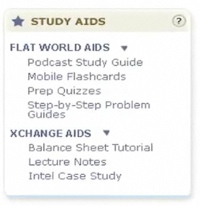A crazy idea
Eric Frank spent 11 years in the dead-tree textbook industry, shimmying his way up the trunk to the branch labeled "Director of Marketing" for Prentice Hall Business Publishing, with 160 sales reps flitting from twig to twig beneath. And then he gave it all up to launch a startup called Flat World Knowledge. His new company's business model: give high-quality textbooks away for free on the web. It doesn't take a psychology prof to ask the question, "Has Eric Frank lost his mind?"
Making people happy
College textbooks are easy to hate. They routinely cost more than $100 per book, and they go through new editions faster than... well, than nothing really; textbooks set the standard for new edition go-throughingness. Students regard the entire system as a scam designed to keep prices artificially high, while professors are largely insulated from price when making course assignment decisions.

Eric Frank
"Who's happy right now?" Frank and his partner Jeff Shelstad asked themselves when considering the textbook market a couple years ago on a business trip together. Their answer ("No one") came as they realized that students felt angry, professors were upset because students complained about prices and tried to cheap out by not buying books, faculty authors found themselves compensated less, and coworkers in the industry believed in education but soon came to feel that the entire textbook operation was a house of cards.
After concluding that the traditional publishing world was unable to go through the necessary transformation, Frank and Shelstad left their companies and founded Flat World Knowledge. It took seven iterations of the business plan, but the duo came up with a business model that turned out to have a surprising similarity to open source software.

Jeff Shelstad
Flat World would become a publisher—commission, edit, and peer review the books—but it would give its titles away free on the web. Students could order paper copies cheaply in color or black-and-white, and the site would sell a host of study aids and services. In addition, teachers could edit, delete, and remix textbooks so that the books precisely match the teacher's approach to a course.
If it sounds quixotic, it's also intended to be good business for everyone. The founders are convinced they can succeed as a new kind of textbook company while lowering costs for students, giving control to professors, and generating more revenue for authors. But to succeed, Flat World needs to confront a couple of major speed bumps in the very real world first.
"Fundamentally, it's about authorship"
A recent report from a collection of student public interest research groups says that students spend $700 to $1,000 on book each year. And while textbook prices are high, current e-textbooks aren't a great alternative.
"Right now, publishers are on a crash course with e-textbooks. They are expensive and impractical for a large portion of the student population," the report says. "Open textbooks are the way to let digital textbooks live up to their potential as a solution to overwhelming textbook costs. They meet the needs of students as learners, while protecting their interest as consumers."
Cheap web textbooks sound great, but Flat World first needs to convince authors, faculty, and students of the new model's benefits. The process begins with authors. Flat World already has 17 books under contract and hopes to have that number up to 22 or 25 by the end of the year.

Without a track record of success or name recognition among the faculty who choose titles, Flat World has sold authors on "the vision" instead. That vision has two main premises: 1) open content is the future (and you don't want to be left behind, do you?) and 2) it can make authors a pile of money (relatively speaking).
Textbook authors incur a significant opportunity cost and are unlikely to sign on the dotted line without believing the Flat World sales pitch. As Frank puts it, "they either believe or they don't." And while the language of belief indicates that Flat World is in some respects still a faith-based venture, Frank has plenty of numbers, too.
Traditionally, textbook authors get a 15 percent royalty on net sales, which puts everyone in a tough situation. Publishers and authors make no money on sales of used books, on photocopies of book chapters from a friend's copy, or textbooks checked out of the library instead of purchased. When a new textbook comes out, only 80 of 100 students will purchase the book; the rest will acquire it in other forms. The second semester that same book is used, only 45 percent buy new books and the rest buy used. By the fourth semester, a publisher sells almost no new books and authors receive almost no royalties. Thus, the pressure to pump out new editions.

Examples of study aids
Flat World may sell
The Flat World model tempts authors by working differently. It gives the book away for free reading on the web, but sells a host of ancillary study guides, flash cards, Kindle versions, and paper copies of books. Given the low prices when compared to traditional textbooks, Flat World makes less on sales the first semester but anticipates much higher purchase percentage rates across following semesters. It also pays authors a 20 percent royalty.
The Flat World model only works if professors are willing to assign the company's textbooks, but Frank is convinced that convincing faculty to assign textbooks from any unknown company is a surmountable challenge.
"Fundamentally, it's about authorship," Frank says. In his view, faculty members don't think about publishers as a "brand"; they think about authors. If Flat World can attract top writers from each discipline, faculty will come around, especially when the cost benefits to students are factored in. But "this will never succeed if we come out with mediocre content" and expect the price to drive it, Frank admits.
reader comments
0